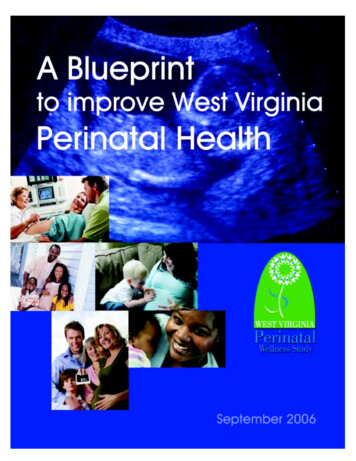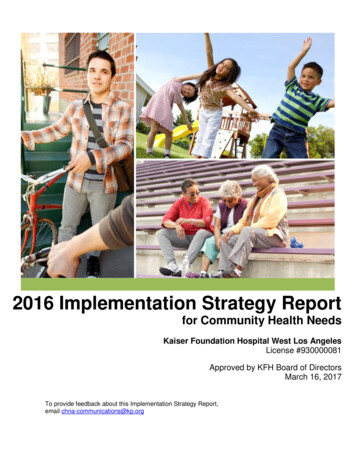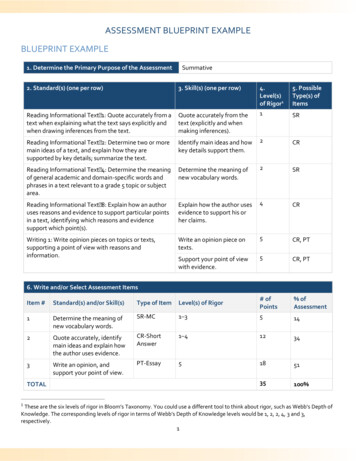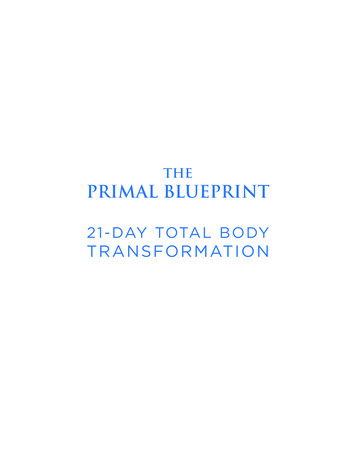
Transcription
A Blueprint to Improve West Virginia Perinatal Health1
The West Virginia Perinatal Wellnes Study is a project ofWest Virginia Community Voices, Inc. andWest Virginia Healthy Kids and Families CoalitionWest Virginia Perinatal Wellness StudyWest Virginia Community Voices, Inc.Nancy J. Tolliver, Project DirectorAnn Dacey, Project Co-Director2207 Washington Street EastCharleston, West Virginia 25311304-342-8237tolliver2@verizon.netVisit our web site for study materials and presentationsutilized in the development of this document.www.wvhealthykids.org2A Blueprint to Improve West Virginia Perinatal Health
A Blueprint to Improve West Virginia Perinatal HealthTable of ContentsAcknowledgementsPartnersPreface 5 6 7Introduction 8 12 12 Chapter 1 – Perinatal Health in West Virginia – Changes Over TimePopulation and Health Outcomes Regionalization and Outreach Education Institutions Providing Obstetrical and Neonatal Care – NICU BedsProviders of Obstetrical CarePhysicians Certified Nurse MidwivesMedical Liability ConcernsEmerging Concerns 18 20 22 22 24 26 28Chapter 2 – Issues Faced by WV Perinatal Providers: The Key Informant Survey Findings from Level I and Level II Obstetrical and Neonatal Facilities and PersonnelFindings from Tertiary Care ProvidersPerinatal Specialists Maternal-Fetal Medical SpecialistsNeonatal SpecialistsMedical Residency Programs 29 31 32 34 34 34 35 38 38 38Breastfeeding Issues and Barriers In-Home Parent Education ProgramsBarriers and Challenges Chapter 3 – Perinatal Study Surveys Perinatal Education and Support Programs Worksite Perinatal Wellness Programs 40 40 43 43Insurers Approaches to Obstetrical Care Management (more)A Blueprint to Improve West Virginia Perinatal Health3
A Blueprint to Improve West Virginia Perinatal HealthTable of Contents (cont.)Chapter 4 – Economic Benefits of Improved Perinatal Outcomes in WVBirthing Cost Savings to Business Human Capital Loss 46 46 47 48Chapter 5 – Policy Recommendations to Improve Perinatal Health 49 49 52 53 Create a Coordinated Statewide Perinatal System Save State Dollars by Reducing Costly Medical ProceduresReduce Exposure to Tobacco Smoke During Pregnancy Reduce Drug and Alcohol Use Among Pregnant WomenImprove Breastfeeding Support and Promotion Recruit and Retain More Obstetric Providers Expand Newborn Screening to 29 Conditions Vision Strategy Action Plan Contributors to Blueprint Measuring ProgressReferences A Blueprint to Improve West Virginia Perinatal Health 55 58 60 62 64 65 66 Improve the Oral Health of Pregnant Women Through Policy and Education Encourage West Virginia Businesses to Offer Perinatal Worksite WellnessChapter 6 – A Blueprint for State Action Improve Perinatal Health and Birth Outcomes of African American Women4 6868686878 71 73
AcknowledgementsSpecial recognition is given to the following individuals and to the organizations they represent, for theirdedication, untiring efforts and collaboration to help us conduct this study, and their willingness to researchand write sections of the Blueprint to Improve West Virginia Perinatal Health.Writers:Ann Dacey, RN, BSNNational Center of Excellence in Women’s Health, West VirginiaUniversity School of MedicineJoe Deegan, LSW, CCAC-SWest Virginia Association of Addiction ProfessionalsPaul Hamilton, PhDCenter for Business and Economic Research,Marshall UniversityBecky King, MATonkin Management GroupCinny Kittle, MSWest Virginia Hospital AssociationRenate Pore, PhD, MPHWest Virginia Healthy Kids and Families CoalitionGina Sharps, RDH,BSWV Healthy Start – HAPI ProjectNancy Tolliver, RN, MSIRWest Virginia Community Voices, Inc.Thank you to Renate Pore for editing this document, to Joe Miller for his assistance posting chapters on theweb site for review and comment by perinatal providers around the state, and to Mountainside Media, Inc. forthe final document layout.The Study to Improve West Virginia Perinatal Wellness and the Blueprint to Improve West Virginia PerinatalHealth have been funded by the Claude Worthington Benedum Foundation with support funds from WestVirginia Community Voices, Inc. and West Virginia Bureau for Public Health; Maternal, Child, and FamilyHealth.A Blueprint to Improve West Virginia Perinatal Health5
PartnersWest Virginia Perinatal Wellness Study 2006American Academy of Pediatrics, West Virginia ChapterAmerican College of Gynecology and Obstetrics, West Virginia Chapter & NationalAmerican College of Nurse Midwives - West Virginia ChapterBlack Medical Society of West VirginiaBureau for Medical Services, West Virginia DHHRBureau for Public Health, West Virginia DHHRCarelinkHospitals and Birthing Centers in West VirginiaMarch of Dimes –West Virginia ChapterMarshall University Medical School – Department of Obstetrics and GynecologyMountain State Blue Cross Blue ShieldMission West Virginia, Inc.Office of Epidemiology and Health Promotion – West Virginia DHHROffice of Maternal, Child and Family Health – West Virginia DHHRPartnership of African American ChurchesPartners in Community OutreachThe Health PlanUnicareWest Virginia Association of Addiction ProfessionalsWest Virginia Center of Excellence in Women’s HealthWest Virginia Children’s Health Insurance ProgramWest Virginia Council of ChurchesWest Virginia Health Care AuthorityWest Virginia Hospital AssociationWest Virginia Kids CountWest Virginia Primary Care AssociationWest Virginia Public Employees Insurance AgencyWest Virginia School of Osteopathic MedicineWest Virginia Section of the Association of Women’s Health, Obstetric, and Neonatal NursesWest Virginia State Medical AssociationWest Virginia University Institute for Health Policy ResearchWest Virginia University Medical School, Morgantown and CAMC CampusesWellness Council of West Virginia -West Virginia Worksite Wellness ProgramsWomen, Infants, and Children (WIC) Food and Nutrition Program – West Virginia DHHR6A Blueprint to Improve West Virginia Perinatal Health
PrefaceNancy Tolliver, RN, MSIR,Clark Hansbarger, MDWhen the Claude Worthington Benedum Foundation issued its annual report in 2005, it asked, “Is it possiblefor a state with a difficult economy to help its kids to better health?” The answer was a resounding, “Yes.”Among other things, if we want to improve the health and well-being of our children, the report advised, wemust begin long before birth. Better health for our children will be the result of better health for pregnantwomen and infants.About 21,000 new babies are born in West Virginia each year. This is a relatively small number - a workablenumber. By working together, we can make sure that 21,000 new babies and their mothers have the best healthcare possible to assure a healthy beginning.While there are solutions to our child health problems, we are concerned that we have made little progressover the past decade in improving infant mortality. The number of low birth weight babies has increased andmore babies are spending the first weeks of life in neonatal intensive care. More and more of our childrensuffer from chronic disease such as asthma, diabetes, and obesity.After taking a close look at perinatal health care in West Virginia, we have determined that our currentsystem of caring for pregnant women and babies should be overhauled.We have also found that there is a desire and strong support to make improvements in perinatal care in WestVirginia. The partners in this study agreed that this is the right time and place for a comprehensive andcollaborative approach. The professional medical and nursing associations, tertiary care facilities, medicalresidency programs, small rural and urban hospitals, birthing centers, nurse-midwives, pediatricians, andobstetricians from around the state told us what should happen to improve care. They also told us that theywant to be a part of the process to overhaul the perinatal health care system.From the initial phase of this study, it appears that most elements of a cohesive system of care are availableand possible. Instead of local and regional systems, however, we need to move toward a statewide approach.We need to better utilize new methods of communication, assure a statewide emergency transportationsystem, provide better support for medical professionals in rural areas, better utilize our perinatal intellectualresources, and more fully implement parent support and education programs already available butunderutilized and underfunded.West Virginians have a history of working together. In perinatal health we have periodically come together toreview and revise how we care for women and children. We have an urgent need to come together again,address our current problems, and use the new technologies to coordinate and support a statewidesystem. The Blueprint to Improve West Virginia Perinatal Health can be our guide. Working together, we canmake it happen.A Blueprint to Improve West Virginia Perinatal Health7
IntroductionNancy Tolliver, RN, MSIRContributors: Jeannie Clark RN; Ann Dacey BSN, RN; Clark Hansbarger, MD; Cinny Kittle, MS;Lois Morgan RN, BSN; Pat Moore Moss, MSWTen years ago, West Virginia birth statistics were much brighter than today. The pre-term rate was 10.7percent; the primary C-section rate was 16.1 percent, and the vaginal births after caesarean section(VBAC) rate was 28.3 percent. Today the corresponding data shows no improvements, in fact, we areworse than the national averages for those indicators.WV DATA19932003Pre-Term 6%If West Virginia could achieve improvement in these numbers fewer babies would be lost and more dollarswould be saved by health insurance payers and by the state of West Virginia.To learn the reasons for West Virginia’s poor perinatal statistics, the Claude Worthington BenedumFoundation awarded 50,000 to the West Virginia Healthy Kids and Families Coalition and West VirginiaCommunity Voices, Inc., to conduct a study on the current status of perinatal health in West Virginia.ProcessThe study began by identifying all potential partners. Some partners made a major contribution to the study andmany others offered support and help.First Lady Gayle Manchin championed the study along with Robert C. Nerhood, MD, Chair, Perinatal Committee,District IV, American Academy of Gynecology (ACOG) and Chair of the Marshall University School of Medicine,Department of Obstetrics and Gynecology; Scott Rotruck, then CEO of the Morgantown Chamber of Commerce;Joan Phillips, MD, pediatrician and president of the American College of Pediatrics – WV Chapter; and BeverlyRailey Walter, Vice President for Programs, Claude Worthington Benedum Foundation.Two institutions dedicated staff to this Study. The West Virginia University School of Medicine, National Centerof Excellence in Women’s Health donated the time of Ann Dacey, project co-director. The West Virginia HospitalAssociation donated the time of Cinny Kittle, Day One Coordinator.Senator Roman Prezioso, Delegate Don Perdue and other legislators lent a hand by sponsoring a joint resolutionduring the 2006 regular legislative session calling for the Study. Several legislators and legislative counselsparticipated in the Perinatal Wellness Summit held May 18, 2006.8A Blueprint to Improve West Virginia Perinatal Health
Identifying the Current StatusTo identify the current status of perinatal wellness in the state, information and data was provided by theorganizations and agencies that follow. The study focused on gathering and considering the most current andaccurate data and information. Most of the data is from the 1999-2004 time period.West Virginia Health Care AuthorityThe WV Health Care Authority analyzed UB-92 Hospital Discharge Data Reports for 1999 through 2004 toidentify important information, including: Major Payer Groups Cesarean Section Rates by WV Hospital Cesarean Section Rates by Payer Group Vaginal Birth After Cesarean Section (VBAC) Rates by WV Hospital Neonatal Intensive Care Unit Utilization in WV Hospitals by Payer Group Neonatal Intensive Care Unit Utilization- Charges and Length of Stay Maternity Care in WV Hospitals –Average and Median Total Charges WV Hospitals and Birthing Centers Providing Maternity ServicesOffice of Epidemiology and Health PromotionThe State Office of Vital Records compiled numerous reports for review including births, low birth weight,infant mortality, premature birth ( 37 weeks gestation), multiple births, and maternal smoking. All data arereported by births by county, by age of mother, and by race of mother. Births with abruptio placenta to motherswho smoked during pregnancy by age of mother are also reported. The Office reported certain medical riskfactors identified by the West Virginia birth certificate, including diabetes, chronic hypertension, hypertensionassociated with pregnancy, eclampsia, abruptio placenta, labor induction followed by c-section rates for firsttime mothers, transfer of infant to a tertiary care facility, neonatal deaths, and postneonatal deaths.Office of Maternal, Child, and Family HealthThe Office of Maternal, Child and Family Health in the WV Department of Health and Human Resourcescontributed several reports including the WV Pregnancy Risk Assessment Monitoring System (PRAMS). PRAMSis an ongoing, population-based surveillance system designed to identify and monitor selected maternal experiences and behaviors. The Office also provided a comprehensive report, Perinatal Care: Improving PregnancyOutcomes 5/4/06, defining the infrastructure of care providers, progress made in access to care, and identifyingsome of the major medical and social factors affecting pregnancy outcomes.The West Virginia University School of Medicine, Department of Pediatrics, Birth Score Program, providedan analysis of the experiences of 12,756 pregnant women, some receiving Right From the Start (RFTS) servicesand some not. This information is extremely useful. It demonstrates that West Virginia has a program in placethat has made significant progress toward improving pregnancy and newborn outcomes. However, only 52percent of the women eligible for RFTS receive services.The Women, Infants and Children (WIC) ProgramWIC is a federally funded program under USDA, that provides education and food for those qualifying for theprogram. WIC provided a report regarding breastfeeding rates of WIC participants for 2004.A Blueprint to Improve West Virginia Perinatal Health9
Gathering Statewide InputProfessionals from all over West Virginia provided information for the study. Hearing and understanding theexperiences and opinions of perinatal providers across the state gave us important information with which tounderstand the data collected. It also allowed us to question the completeness of some methods of collectingand reporting data that are used for program development purposes. Several surveys to gather input fromperinatal providers across the state were conducted.Surveys conducted as part of this study include:Worksite Wellness and Perinatal Health Survey: Nationwide, many companies have found they can savemoney in insurance costs because of better pregnancy outcomes with worksite programs focusing on prenatalwellness. The March of Dimes found that it is not uncommon for companies to spend 50 percent or more oftheir total health care bills on pregnancy related costs. We attempted to survey businesses in West Virginia,sending surveys to all members of the Wellness Council of West Virginia and posting the survey on ourwebsite. Only seven companies responded to the survey and none reported a focus on perinatal wellness.Perinatal Education and Support Programs and Services Survey: In an effort to learn more about education and support programs and services available to pregnant women and new mothers in West Virginia, wesent more than 1,800 surveys to potential providers during April 2006 and posted the survey on the web site.The surveys focused on three categories of providers: Non-hospital and hospital-based breastfeeding education programsIn-home and out-of-home perinatal education and support programsPerinatal product retailersAlthough the return on the survey was not extensive, the information gained was extremely valuable inidentifying gaps in services and needed improvements. The survey results are used in this report in establishing policy recommendations related to improving breastfeeding, nutrition, and parent support.The West Virginia Key Informant Survey sought opinions and experiences of medical and nursing providers ofperinatal care regarding why West Virginia has not made the same progress in reducing infant mortality and lowbirth weight as the rest of the nation. The survey was intended to reach those practicing in rural areas of the state,as well as urban areas. It was the hope of the study that West Virginia medical and nursing personnel, not able toparticipate in the Perinatal Wellness Summit, could provide their expert opinions and experiences to the issues.The West Virginia Key Informant Survey was conducted from March 21, 2006 through May 2, 2006. Thesurvey tool contained two open-ended questions to gain the opinions of health professionals regarding1) health and health care concerns related to the state’s continuing high rate of infant mortality, and2) potential solutions that should be considered to help reverse the current trend in infant mortality. Thesurvey was conducted through a variety of methods, including U.S. Postal Service, web site posting, fax,and e-mail.The survey was conducted with the assistance of the following professional associations: The American Academy of Pediatrics – West Virginia Chapter The American College of Obstetricians and Gynecologists - National and West Virginia Chapters The American College of Nurse Midwifery – West Virginia Chapter The West Virginia Hospital Association The West Virginia State Medical AssociationThe West Virginia Key Informant Survey findings served as the primary source for policy prioritiesidentified during the West Virginia Perinatal Wellness Summit on May 18, 2006. The survey response ratewas excellent. The provider types, number and percent responding are listed in the chart on the next page.10A Blueprint to Improve West Virginia Perinatal Health
Provider TypeNumberDeliveringIn 2006Obstetrician/GynecologistCertified Nurse MidwivesFamily Practice PhysiciansER PhysiciansPediatriciansHospitals & Birth Centers14541190034Number onDistributionListNumberRespondingto Survey331952382119834PercentageSurvey Respondentsto Providers28%46%26%19%62%In addition, expert presenters for the Summit submitted policy recommendations for consideration.Summit Gathering: On May 18, 2006, eighty perinatal care providers gathered in Charleston to presentadditional information that could be used to further analyze the problems and identify potential solutions. Thisprestigious group included representatives of each professional association focused on perinatal care: hospitals,tertiary care facilties, obstetrical and pediatric residency programs, and outreach programs in the state.Topics presented include the following listed by presenter:The State of Perinatal Wellness in WV – Robert Nerhood, MDWhat We Know From Birth Score – Martha Mullett, MDLeading Medical Cause of Prematurity & Eclampsia – David Chafin, MDPerinatal Healthcare Disparities in WV – Luis Bracero, MDMother’s Little Helper: What Do Pregnant Smokers Have to Say? – Robert Anderson, MAOral Health and Perinatal Wellness – Richard Meckstroth, DDSKey Informant Survey Findings – Nancy Tolliver, RN, MSIRObstetrical Providers in WV – Ann Dacey, RN, BSNPrenatal Drug Abuse – Stefan Maxwell, MDWV Neonatal Transport Data – Janet Graeber, MDCost Savings Resulting from Improved Perinatal Outcomes in WV – Calvin Kent, PhDANGELS Program – Arkansas – Curtis Lowery, MDPerinatal Policy Implications to Consider –Pat Moore-Moss, MSWInformation and data from each of the presentations was essential in formulating the policy priorityrecommendations that appear later in this report.A Blueprint to Improve West Virginia Perinatal Health11
Chapter 1Perinatal Health in West Virginia – Changes Over TimePopulation and Health OutcomesAnn Dacey, RN, BSNContributors: Tom Light, BA; Daniel Christy, MPAPopulation Trends 1947 – 2004: Since 1947 the size of the population, numbers of births, birth rates, andinfant mortality have all declined in West Virginia. Although there have been very slight increases in someyears, the annual number of births in West Virginia has declined from a high of 54,170 in 1947 to 20,911 in2004. West Virginia’s population peaked in 1950 with 2,005,552 people and has stayed about 1.8 millionsince 1992.Year# BirthsPopulation ,8601.81200420,9111.82West Virginia’s birth rate has been below the national average since 1980. In 2004, the overall birth rate was11.5 births per 1,000 population compared to a U.S. rate of 14.1 per thousand.12A Blueprint to Improve West Virginia Perinatal Health
Teen Birth Rate: The teen birth rate in West Virginia has declined by 23 percent since 1991. In 2003, WestVirginia’s teen birth rate was higher than the national average but it was the birth rate to older teens ages 18 – 19that accounted for this. West Virginia was below the national average in births to younger teens ages 15 – 17.West Virginia and U.S. Teen Birth Rates 15-19 in 1990 and 2003West Virginia199158.0200344.8United States61.841.62003 WV and U.S. Teen Birth Rates 15-19Total Teen Birth RateWest VirginiaUnited States44.841.6Teen Birth RateAges 15 - 1721.122.4Teen Birth RateAges 18 - 1979.770.7Births to Unmarried Women: The percentage of births occurring out of wedlock has been slowly rising inWest Virginia, particularly among unmarried teen mothers where it rose from 71.4 percent in 2002 to 76.5percent in 2004. In 1950, five percent of births were to unmarried women. In 2004, 34.7 percent of birthswere to unmarried women.A Blueprint to Improve West Virginia Perinatal Health13
Percent Of Births To Unmarried Women1950All Women5%2004All Women34.7%2004Teens76.5%Infant Mortality Rate: Infant mortality is the result of a complex set of biological and social factors, andinfant deaths have long been viewed as an important indicator of a population’s health. From 1976 to 1988there was considerable effort in West Virginia to reduce the incidence of neonatal mortality and post-neonatalmortality. The infant mortality rate in West Virginia made the most rapid decline in the 1970s and continuedto decline in the 1980s until 1989. Many factors may be responsible for the decline. The advent of a strongfederal and state supported family planning program and the legalization and availability of abortion may alsohave played important roles in reducing infant mortality. For most of the 1980s the infant mortality rate inWest Virginia was below the national average.While the rest of the nation has shown an almost steady decline in the rate of infant mortality since1994, West Virginia’s rate has remained slightly above the national average for each of the last 10 years.Because of the relatively low numbers of births in West Virginia, it is best to look at infant mortality rates infive-year averages.The average infant mortality rate for the last five years of available datashows West Virginia’s infant mortality rate higher than the national average.U.S. and WV Infant Mortality Rates 2000 – .67.8U.S.6.96.876.96.86.9Smoking and Alcohol Use During Pregnancy: West Virginia leads the nation in the percentage of womenwho smoke during pregnancy. The national percentage is just over ten percent and the percentage of WestVirginia women who smoke is close to 26.8 percent. There has been little improvement since 1990 when itwas 27.3 percent. Forty-one percent of Medicaid covered pregnant women smoke. In 2004, women whosmoked experienced more low birth weight babies than women who did not smoke. Alcohol use among WestVirginia pregnant women is lower than the national rate.14A Blueprint to Improve West Virginia Perinatal Health
Smoking and Alcohol Use Among Pregnant Women% Women who smoke26.8% (2004)10.2% (2002)West VirginiaUnited States% Women who use Alcohol0.6% (2004)0.8% (2002)Smoking and Low Birth Weight BabiesPercent of Babies Born Low Birth Weight in 2004WV Pregnant SmokersWV Pregnant Non-Smokers14.3%7.2%Low Birthweight Births and PrematurityPrematurity and smoking are the leading causes of low birth weight. West Virginia has had a higher thannational average percentage of low birth weight babies every year since 1994. Likewise we have had a higheraverage of premature births every year sine 1995.US and WV Percentages of Low Birth Weight 7.27.37.37.47.57.67.67.67.77.87.98.1Since the annual numbers of births to black women are so much smaller, five-year averages are shown on thenext page.Prenatal CareEarly prenatal care has been associated with better birth outcomes. West Virginia women have received earlyand adequate prenatal care at rates better than the rest of the country since 1998. In 2004, 86 percent of WestVirginia mothers with known prenatal care began their care during the first trimester of pregnancy, comparedto 83.9 percent of mothers nationwide in 2004.A Blueprint to Improve West Virginia Perinatal Health15
Some Data on West Virginia Births by RaceWest Virginia has little racial diversity with less than 5 percent of all births to women of non-white races.Among women with known prenatal care, more white mothers than black mothers began care during the firsttrimester. African American women are much more likely to have a low birth weight baby or death of a babythan a white woman.2004 WV Births by RaceFactor:WhiteAfrican-AmericanOtherNumber of Births19,982661268Percent of all Births95.6%3.2%1.3%1st Trimester Prenatal Care86.3%76.3%8.2%No Prenatal Care0.6%1.1%**Infant Mortality Rate7.415.13.7Low Birth Weight9.2%14.2%6.2%Since the annual numbers of births to black women are so much smaller, five-year averages are shown below.Low Birthweight Births by Race of MotherWest Virginia Residents, 2000-2004Excludes Unknown entofTotalWhiteBlackAll Other99,4793,5099248,676473808.7%13.5%8.9%WV Total103,9129,2298.9%A Blueprint to Improve West Virginia Perinatal Health
Mothers Who Smoked During Pregnancy by Race of MotherWest Virginia Residents, ofTotalWhiteBlackAll Other99,4793,50992426,3399356926.7%26.8%7.7%WV Total103,91227,34326.5%Note: Percentage excludes unknown smoking statusInfant Deaths by Race of MotherWest Virginia Residents, 2000-2004RaceNumberofBirthsNumber ofInfantDeathsRate per1,000BirthsWhiteBlackAll Other99,4793,5099247446217.517.71.1WV Total103,9128077.8A Blueprint to Improve West Virginia Perinatal Health17
Regionalization and Outreach EducationAnn Dacey, RN, BSNContributors: Stephen Bush, MD; Brenda Daugherty, RN, MSN, NNP; Janet Graeber, MD; Diane Kopcial,RN, MSN; Pat Moore-Moss, MSW; Marlene Merkel; Martha Mullett, MD; Robert Nerhood, MD; BarbaraNightengale, RN, NNP; Susan Watkins, RN, MSN.A system of perinatal regionalization has been in place in West Virginia since the mid 1970s shortly afterneonatal intensive care units (NICUs) were opened in Morgantown, Huntington, and Charleston. TheCharleston and Morgantown centers are affiliated with West Virginia University School of MedicineDepartments of Pediatrics and Obstetrics and Gynecology. The Huntington facility is affiliated withMarshall University School of Medicine Departments of Pediatrics and Obstetrics and Gynecology.In 1975, the Maternal and Child Health Division of the West Virginia Department of Health funded the WestVirginia Committee for Perinatal Health to plan and implement regionalization of perinatal care in the state.Reports and recommendations from this committee were published in 1976 and 1979. Title XIX federalfunding further supported education and outreach in a program called the West Virginia Improved PregnancyOutcome Project. When that funding ended in the early 1980s, the West Virginia Bureau for public healthcontinued to support regionalization.Unlike other states that closed low volume obstetric facilities, West Virginia elected to develop a perinataloutreach education and referral system. The motivating facto
web site for review and comment by perinatal providers around the state, and to Mountainside Media, Inc. for the final document layout. The Study to Improve West Virginia Perinatal Wellness and the Blueprint to Improve West Virginia Perinatal Health have been funded by the Claude Worthington Benedum Foundation with support funds from West










